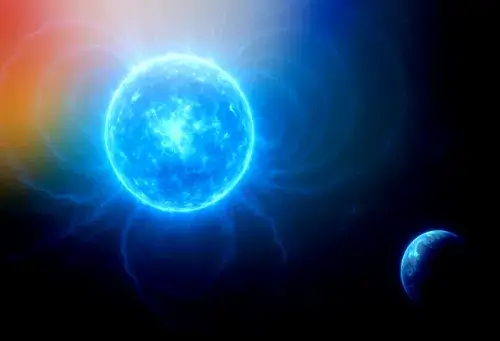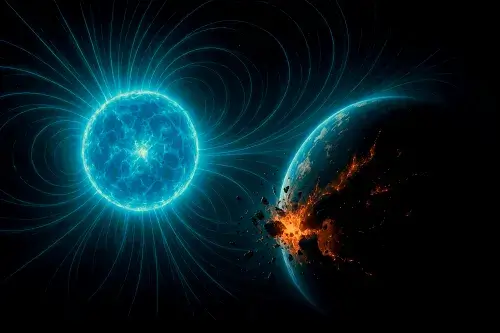Dead Star. The cosmos is a tapestry woven with wonders and terrors. From the silent, spiraling galaxies to the breathtaking nebulas where new stars are born, space often fills us with awe.
But among these cosmic marvels lurk objects of immense power, true “villains” that defy our understanding of physics. They are the remnants of stellar giants, and their existence is a stark reminder of the universe’s capacity for destruction.
Dead Star.
One such object, a magnetar known as SGR 0501+4516, is currently hurtling through space at a staggering 180,000 kilometers per hour, and a recent discovery has sent shivers through the scientific community: it’s headed in our general direction.
While it is still light-years away, the very existence of such an object raises a terrifying question: what would happen if a magnetar came close to Earth?
According to NASA, the consequences would be catastrophic. The sheer power of its magnetic field and the bursts of radiation it emits could wipe out all electronics on the planet and, in a worst-case scenario, strip every living thing down to its atomic components.
And though the distance provides a safety cushion for now, new research has revealed that this magnetar has shifted its course and is moving in an alarming direction for our section of the galaxy.
The “Zombie Star”.
What is a Magnetar?
Scientists have an unsettling nickname for magnetars: “zombie stars.” This isn’t just for dramatic effect.
The name perfectly encapsulates what these objects are the animated remains of a once-mighty star, unexpectedly “rising” from its own ashes to continue influencing its surroundings not with light and warmth, but with a terrifyingly potent magnetic field and deadly flashes of radiation.
The life of a magnetar begins with a star much larger than our Sun a colossal stellar giant. For millions of years, this star burns brightly, fusing elements in its core.
But when it runs out of fuel, gravity wins. The star’s core collapses in on itself, triggering one of the most violent events in the cosmos: a supernova.
The outer layers of the star are blown away in a brilliant, final burst of light and energy that can outshine an entire galaxy for a few weeks. What’s left behind is the crushed remnant of the star’s core.
This core is not a black hole, but something else entirely a neutron star. Picture a sphere with a radius of only 10 to 20 kilometers, but with a mass greater than that of our Sun.
A single teaspoon of neutron star material would weigh billions of tons. It is an object of unimaginable density, where the laws of physics are pushed to their absolute limits.
But what makes a neutron star a magnetar?
It’s the presence of an incredibly, almost impossibly, strong magnetic field. The star’s original magnetic field lines are compressed along with the core during the supernova explosion, intensifying them to a degree that is difficult for us to comprehend. The result is a magnetar.
The Most Magnetic Objects in the Universe.
Magnetars are, without a doubt, the most magnetic objects in the known universe. Their magnetic fields are a hundred trillion times stronger than Earth’s.
To put that into perspective, the magnetic field of a magnetar is so powerful that if you were to stand 1,000 kilometers away from it, the field would be strong enough to strip the electrons from the atoms in your body, an effect known as “spaghettification” in a magnetic field.
But the effects of a magnetar’s power can be felt at a much greater distance. Even if a magnetar were to be as far as 10 light-years from Earth, it could still have a devastating impact.
Here’s what that level of magnetic power could do:
• Electronic Obliteration: The magnetic field would easily destroy all electronics. From a distance, it would corrupt hard drives, wipe banking cards, fry phone circuits, and render every satellite in orbit useless. The electronic backbone of modern civilization would be instantly erased.
• Atmospheric Chaos: The immense energy of the magnetar would generate powerful electromagnetic storms in Earth’s atmosphere, disrupting the planet’s magnetosphere and potentially causing a global-scale aurora borealis that would be far from beautiful.
• Biological Destruction: The most terrifying threat is the effect on living organisms. At a certain distance, the magnetic field and accompanying radiation could be strong enough to rip apart the atomic structure of biological molecules, essentially sterilizing any planet in its path.
To understand the sheer scale of this threat, consider this comparison: the closest star to us, Proxima Centauri, is a mere 4.24 light-years away. A magnetar doesn’t have to “collide” with us; it just needs to get close enough for its gravitational and magnetic influence to wreak havoc.
The Mystery of SGR 0501+4516.
For a long time, SGR 0501+4516 was not considered a threat to the Solar System. It was just another intriguing object in the vastness of space.
However, recent astronomical observations have painted a new and more alarming picture. Using advanced telescopes, scientists have been able to calculate a change in its speed and trajectory.
While it is currently located about 15,000 light-years away, and will take millions of years to get here, the fact that its path has shifted to put it on a course toward our part of the galaxy is a cause for concern.
Key facts about SGR 0501+4516:
• Distance from Earth: ~15,000 light-years
• Speed: ~180,000 km/h
• Magnetic Field Strength: 100 trillion times stronger than Earth’s
• Potential Damage: Total electronic failure and the complete sterilization of a planet’s biosphere.
Another puzzle that adds to the intrigue of this magnetar is its formation. Scientists have determined that SGR 0501+4516 did not form as the result of a typical supernova explosion. This leads to two major hypotheses.
It could either be much older than the assumed 20,000 years for a magnetar of its type, or it could have formed through an entirely different mechanism.
One of the leading theories is that it was created by the merger of two smaller neutron stars, a rare and violent event that would have created an object of such immense power and left a different kind of cosmic fingerprint than a supernova.
The Impossibility of Defense.
So, what can we do to protect ourselves from a potential threat like a magnetar? The short answer is: nothing. The forces at play are on a scale that humanity has no hope of countering.
The energy is so profound that any attempt to use a magnetic shield or any other defensive measure would be completely futile. The laws of nature, in this case, are simply too powerful.
We’ve already had a small taste of this immense power. In 2004, another magnetar, named SGR 1806−20, experienced a colossal outburst. This event, known as a magnetar flare, was an eruption of gamma-ray radiation so powerful that it actually damaged satellites orbiting Earth.
And this happened from a distance of 50,000 light-years! It’s staggering to think about the damage it would have caused if it had been closer. This event was a wake-up call, showing us that even from across the galaxy, these objects can and do affect us.
However, there is a silver lining to this cosmic horror story. Even at its current breakneck speed, SGR 0501+4516 will take millions of years to reach a distance that would be considered dangerous for our Solar System.
This gives humanity an incredible amount of time to prepare. In millions of years, we could become a multi-planetary or even a truly interstellar civilization.
With that kind of time, we may have the opportunity to develop technologies and strategies to either mitigate such threats or, more likely, simply move beyond them.
The story of SGR 0501+4516 isn’t just a tale of a distant cosmic villain; it’s also a reminder of the need for humanity to continue to explore and understand the universe, because one day, that knowledge might be the key to our survival.





